At Access Rehabilitation Equipment, we commit to providing you and your loved ones solutions for life! Fitting your lifestyle, each aid and equipment is tailored to the unique challenges you are facing, so work with us to find the independence and mobility you want!

Make your home senior-safe by adding the best bed rails to secure their safety and well-being and to allow them to live more independently, needing less help from others while aging in place. Since an elderly spends a significant portion of their time in bed, it is imperative to enhance home safety by making the bedroom safer to support fall prevention for the older people in your life. Supportive structures such as bed rails are a great solution to minimise the risk of falling out of bed and ensure seniors don't need to roll themselves to gain bed mobility.
Also known as bed side rails, bed guard rails, and bed safety rails, they come in a range of styles, types, and sizes. Many options offer additional safety and convenience features, such as height adjustability, foam for a better grip and storage compartments. This article will provide a comprehensive guide to the best bed rails available for elderly individuals.
Why Bed Rails Matter for Seniors

Elderly individuals face an increased risk of falls and mobility challenges due to a combination of factors. Age-related muscle weakness, decreased bone density, and changes in balance can lead to instability. Chronic conditions like arthritis, Parkinson’s disease, and osteoporosis can further compromise mobility. Declining vision and cognitive impairments may affect spatial awareness and coordination. It’s crucial to address these factors through home modifications and assistive devices to mitigate the potential for falls and enhance seniors’ overall safety and quality of life.
By providing a sturdy structure to hold onto, bed rails allow seniors to navigate in and out of bed with greater ease and confidence. This added stability reduces the risk of potentially dangerous falls during these transitions, promoting a safer sleeping environment.
Factors to Consider When Choosing Bed Rails:
There are several factors to consider when choosing the best bed rail for elderly. The bed’s compatibility, the user’s weight, and height adjustability are just a few of the things to keep in mind.
-
Compatibility - First, make sure that the bed rails are compatible with the type of bed frames the elderly person is using, such as a standard bed or adjustable bed. Bed rails for elderly aren’t one-size-fits-all, so it’s necessary to conduct research and collect all the important information initially. Avoid bed rails that require seniors to climb over them to get in and out of bed, as climbing can lead to falls.
-
Height and Length - Choose bed rails with appropriate height and length to provide adequate support while getting in and out of bed and to prevent accidental falls during sleep. The bed rails should safely accommodate the size of the senior to ensure that the rails are not too big, which could lead to falling out of bed, or too small, resulting in insufficient protection.
-
Support and Weight Capacity - The most important consideration is knowing that a bed safety rail can provide adequate support and stability. Check the weight capacity of the bed rails to ensure they can safely support the elderly person’s weight. If you’re concerned about weight being a factor, there are bed rails specifically designed for larger patients.
-
Ease of installation - Opt for bed rails that are easy to install securely onto the bed frame and can be removed or folded when not needed, reducing the risk of accidents or complications during the installation process. This is particularly crucial for both the elderly individual and the caregiver.
-
Height Adjustability - Some bed rails offer adjustable height to accommodate different types of mattresses and bed frames. This is another essential factor to think about when purchasing bed rails for the elderly, as it enables you to customize the rail’s height to meet their particular requirements and comfort.
Key Features to Look for in Bed Rails:
When choosing the best bed rail for elderly, several key features are essential for safety and comfort:
-
Secure Locking Mechanisms: Bed rails should have reliable locking mechanisms to make sure they remain firmly in place once installed. This prevents accidental collapses or shifting during use, which can be dangerous for elderly people.
-
Comfortable Hand Grips: Hand grips or handles should be ergonomic and comfortable to hold. This not only provides a secure grip for seniors when they need assistance getting in and out of bed but also reduces the risk of hand strain or discomfort.
-
Sturdy Construction: The best bed rails must be constructed from durable materials that can withstand the weight and pressure exerted on them. Sturdy construction means the bed rails remain stable and reliable over time, enhancing safety.
-
Safety Straps: Some bed rails like single-sided bed rails come with additional safety features such as straps that secure the rail to the bed frame, providing an extra layer of stability and preventing unintended movement.
Types of Bed Rails for Elderly:
Bed side rails are built to accommodate most size home beds. There are many different types of bed rails available in the market—each has unique features and benefits:
- Full-length bed rails: This type of bed rails is the most common type of bed side rail, which can be either fixed or adjustable. It extends along the entire length of the bed, running parallel to the mattress.
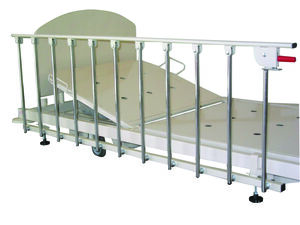
Benefits:
A full-length bed rail provides a way to keep the occupant from falling out of bed. Since it is in full-length style and design, these bed rails can provide the complete coverage of protection for elderly individuals who require maximum support.
Drawbacks:
Full-length bed rails provide the most comprehensive protection; however, these rails can make it hard for seniors to get in and out of bed independently. There’s also a risk of entrapment or injury if the person attempts to climb over the rail, especially if they have cognitive or mobility issues.
Full length-bed rails, adjustable ones in particular, can be more expensive compared to other types of bed rails.
- Half-length bed rails: A half-length bed guard rail extends from the headboard to the middle of the bed frame. Typically, they are positioned either at the head or the foot of the bed. Half-length bed rails can be especially useful for elderly individuals who can get in and out of bed independently but still need extra support.
Benefits:
Half-length bed rails provide easier access for elderly individuals to get in and out of bed. This can be especially important for those with mobility challenges. With shorter rails, there is also a lower risk of entrapment in the railings, which can be a concern with full-length bed rails.
Drawbacks:
Half-length bed rails offer less coverage, so they may not provide as much protection against falls compared to full-length rails. This can be a concern for individuals at a higher risk of rolling out of bed.
Proper positioning of half-length bed rails is crucial to ensure they are effective at preventing falls. Incorrect placement can lead to gaps that may not provide sufficient protection.
- Adjustable bed rails: Adjustable bed rails offer an ideal solution for bedroom mobility as they can be adjusted either up or down or width-wise to suit a person’s particular needs based on their size and other factors. Additionally, these rails can be minimised or folded away when they are not in use.
Benefits:
Adjustable bed rails offer versatility by accommodating different types of mattresses, bed frames, and user needs. The ability to tailor their height and width can contribute to better safety, reducing the risk of falls or entrapment.
Drawbacks:
Some adjustable bed rails may be more complex to set up and adjust, requiring careful attention to instructions and potential tools. When used in a facility setting, it is essential that all staff are trained on how to use these rails. The adjustable mechanisms may also require occasional maintenance to ensure they function correctly over time.
- Floor-mounted bed rails: Unlike traditional bed rails that attach to the bed frame or mattress, floor-mounted bed rails are securely anchored to the floor near the bed.
Benefits:
Floor-mounted bed rails provide a high level of stability and support because they are securely anchored to the floor. The clearance between the rail and the floor can also facilitate wheelchair transfers or the use of other mobility aids.
Drawbacks:
Floor-mounted bed rails are intended for more permanent installation and may require professional installation to ensure they are securely attached to the floor. This makes these types of bed rails less suitable for situations where mobility aids need to be used in different rooms.
Top 5 Bed Rails for Elderly:
-
Removable Adjustable Bed Rail - Removable dropside bed rails are characterised by their ability to be easily removed or lowered, providing flexibility and convenience. It slides between the mattress and bed base, providing a supportive rail along the bedside. The reason it’s ranked at the top is that it meets the balance between security and stability without interfering with nighttime movement. This is a good choice for the elderly for several reasons:
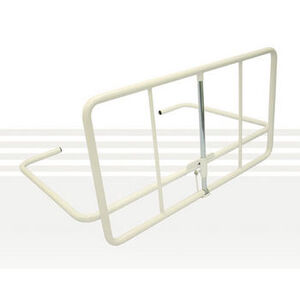
Key features:
- When needed, the rail can be raised and secured in an upright position to prevent falls.
- The drop-side design allows for easy access to and from the bed, making it more convenient for the elderly person to get in and out of bed independently or with minimal assistance.
- Assistance with tasks like changing bed linens, personal care, or medical procedures is easier.
- Compatible with various bed types, including standard and hospital beds.
-
Removable Compact Bed rail - The process of setting up and adjusting large bed rails can be quite time-consuming. So if you face that problem, this removable bed rail is the perfect solution to ease your life from that struggle. It fits any type of bed and is easy to install. All you need to do is lift your mattress and neatly tuck the rail underneath it, and you’re all set.
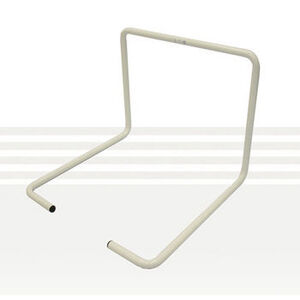
-
Bed Pole with adjustable Crook Handle: As an alternative to bed rails for elderly, you can also install a removable single bed pole to assist with getting in and out of bed. It features a crook handle that serves as a handhold that can be gripped by a senior to aid in sitting up, standing, or repositioning in bed.
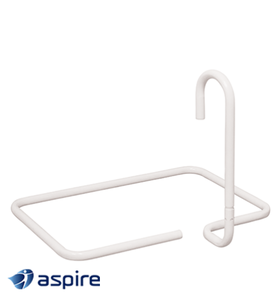
Key features:
- The shaped handle can be located in four positions for added user comfort.
- It’s compatible with single, double, queen, and king-size beds.
- The pole can be easily removed and dismantled for easy storage, making it perfect for traveling.
- The crook handle position can also be adjusted , offering multiple gripping options.
- The base of the pole is positioned under the mattress.
-
Clamp on fixed bed rail: For maximum senior safety, you won’t do better than this clamp on fixed bed rail. It has been tested and found to be in full compliance with Australian standards. This rail is user-friendly, features a powder coated finish, and is designed to minimise the risk of entrapment. This model is only suitable for electric adjustable beds that have a metal frame for the rail to clamp on to.
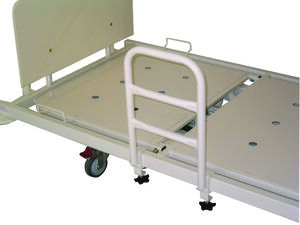
-
Full Length Fold Down Bed Rail: This folding side bed safety rail provides seniors with utmost safety and protection while lying in bed and also while getting in and out of bed. The bed rail effortlessly glides to either side of the bed and bolts on with a slip-on attach system. Each side rail has four rails in total and can be fully folded down, ensuring maximum comfort and safety. Made suitable for electric beds, this is a must-have for elderly who need added safety and support in bed.
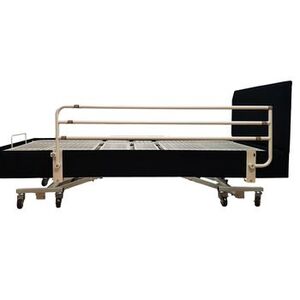
User Tips for Maximising Bed Rail Benefits:
Using bed rails effectively is essential for the safety and comfort of seniors and their caregivers. By following some guidelines, you can be assured that these safety rails serve their intended purpose. Here are some tips to maximise their benefits:
- Proper Installation: Follow the manufacturer’s instructions when setting up bed rails to ensure a proper fit. Bed rails should be positioned properly and should not leave gaps where a senior could become trapped.
- Bed Compatibility: Bed rails can only be used with beds that they are compatible with and should be fitted in line with manufacturer’s instructions.
- Height Adjustment: If the bed rails are height adjustable, set them at a level that provides the necessary support and prevents falls. Ensure they are neither too high nor too low for the elderly.
- Cleaning: Regularly clean the bed rails to maintain hygiene. Use a mild, non-abrasive cleaning solution and a soft cloth to wipe down the rails.
- Maintenance: Examine the bed rails for signs of wear, loose attachments, or damage. Bed rails should be maintained following the guidelines provided by the manufacturer.
- Repositioning: Use proper lifting and transferring techniques to avoid straining or causing discomfort to the senior.
What are the alternatives to bed rails for the elderly?
While bed rails are popular, they may not be ideal for everyone. Consider alternative measures for a safer and more secure environment, such as bed alarms which provide a warning to alert caregivers when the elderly attempt to get out of bed, placing a crash mat to serve as a protective cushion to help prevent injury for seniors who roll out of bed. These options can present a similar purpose depending on the senior’s needs, though they do not provide the same level of assistance when getting in and out of bed and repositioning. As a caregiver, it’s crucial to know that bed rails should not be relied upon as a substitute for proper monitoring.
Conclusion—Making the Right Choice:
Bed rails are essential tools in promoting the safety and well-being of elderly individuals. They provide stability, prevent falls, and assist with repositioning, enabling seniors to maintain independence and dignity. Properly installed and maintained bed rails reduce the risk of accidents, contribute to better sleep quality, and offer peace of mind to caregivers and family members.
However, it's crucial to use bed rails correctly, considering individual needs, preferences, and alternative safety measures to ensure their effectiveness in enhancing the overall safety and comfort of elderly individuals. We recommend consulting with your health professional or therapist for advice on whether bed rails are appropriate and which type and style could work best for you to ensure that your specific medical needs are taken into consideration.
Frequently Asked Questions
Are bed rails safe for seniors?
Bed rails, bed poles, and bed sticks are safe for seniors when installed following the correct precautions and procedures. However, bed rails can be unsafe if the important steps to mitigate risks are neglected. For instance, if a senior is likely to move around a lot during sleep and has the potential to get caught between the bed rails, it’s crucial to find a product that has a cover that can prevent this. Also, if the user has limited strength and may be prone to slipping on the metal railings, certain bed rails come with anti-slip foam covers. Ultimately, bed rails may not be suitable for all elderly, as individual health conditions and preferences vary, so a personalized assessment is necessary.
When should you not use bed rails?
Bed rails should not be used in certain situations or for specific individuals to ensure their safety and well-being. One key instance is when dealing with active sleepers who tend to move around frequently during sleep. In such cases, bed rails may pose a risk of entrapment or getting caught. Additionally, bed rails should not be relied upon as the sole means of fall prevention for those at high risk of falling, as they may not provide adequate protection. Cognitive impairments, like dementia, can also make bed rail usage inappropriate, as they may not understand their purpose and might attempt to climb over them.
Bed rails should not obstruct access to essential medical equipment and must not interfere with emergency egress from the bed. For individuals with fragile skin or a risk of pressure sores, bed rails should be used cautiously due to potential pressure point issues. When more suitable alternatives are available, bed rails may not be necessary.


 Providing solutions for life
Providing solutions for life







